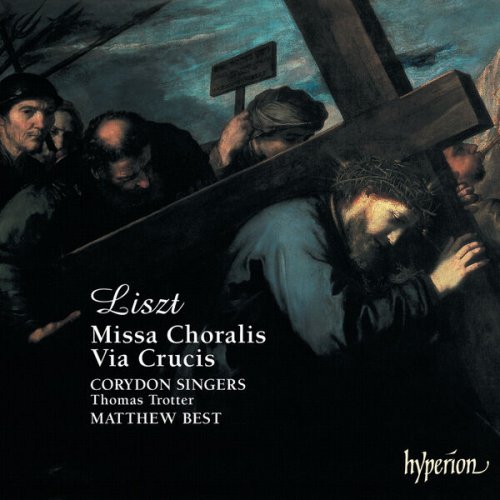
Corydon Singers, Thomas Trotter, Matthew Best - Liszt: Missa Choralis & Via Crucis (2000)
BAND/ARTIST: Corydon Singers, Thomas Trotter, Matthew Best, Elizabeth Atherton
- Title: Liszt: Missa Choralis & Via Crucis
- Year Of Release: 2000
- Label: Hyperion
- Genre: Classical
- Quality: FLAC (tracks + booklet)
- Total Time: 1:12:48
- Total Size: 249 MB
- WebSite: Album Preview
Tracklist:
01. Liszt: Missa choralis, S. 10: I. Kyrie
02. Liszt: Missa choralis, S. 10: II. Gloria
03. Liszt: Missa choralis, S. 10: III. Credo
04. Liszt: Missa choralis, S. 10: IV. Sanctus
05. Liszt: Missa choralis, S. 10: V. Benedictus
06. Liszt: Missa choralis, S. 10: VI. Agnus Dei
07. Liszt: Via Crucis, S. 53: Introduction. Vexilla regis prodeunt
08. Liszt: Via Crucis, S. 53: Station 1. Jesus Is Condemned to Death
09. Liszt: Via Crucis, S. 53: Station 2. Jesus Takes Up the Cross
10. Liszt: Via Crucis, S. 53: Station 3. Jesus Falls the First Time
11. Liszt: Via Crucis, S. 53: Station 4. Jesus Meets His Blessed Mother
12. Liszt: Via Crucis, S. 53: Station 5. Simon of Cyrene Helps Jesus Carry the Cross
13. Liszt: Via Crucis, S. 53: Station 6. Veronica Wipes the Face of Jesus
14. Liszt: Via Crucis, S. 53: Station 7. Jesus Falls the Second Time
15. Liszt: Via Crucis, S. 53: Station 8. The Women of Jerusalem Weep for Jesus
16. Liszt: Via Crucis, S. 53: Station 9. Jesus Falls the Third Time
17. Liszt: Via Crucis, S. 53: Station 10. Jesus Is Stripped of His Clothes
18. Liszt: Via Crucis, S. 53: Station 11. Jesus Is Nailed to the Cross
19. Liszt: Via Crucis, S. 53: Station 12. Jesus Dies on the Cross
20. Liszt: Via Crucis, S. 53: Station 13. Jesus Is Taken Down from the Cross
21. Liszt: Via Crucis, S. 53: Station 14. Jesus Is Laid in the Tomb
01. Liszt: Missa choralis, S. 10: I. Kyrie
02. Liszt: Missa choralis, S. 10: II. Gloria
03. Liszt: Missa choralis, S. 10: III. Credo
04. Liszt: Missa choralis, S. 10: IV. Sanctus
05. Liszt: Missa choralis, S. 10: V. Benedictus
06. Liszt: Missa choralis, S. 10: VI. Agnus Dei
07. Liszt: Via Crucis, S. 53: Introduction. Vexilla regis prodeunt
08. Liszt: Via Crucis, S. 53: Station 1. Jesus Is Condemned to Death
09. Liszt: Via Crucis, S. 53: Station 2. Jesus Takes Up the Cross
10. Liszt: Via Crucis, S. 53: Station 3. Jesus Falls the First Time
11. Liszt: Via Crucis, S. 53: Station 4. Jesus Meets His Blessed Mother
12. Liszt: Via Crucis, S. 53: Station 5. Simon of Cyrene Helps Jesus Carry the Cross
13. Liszt: Via Crucis, S. 53: Station 6. Veronica Wipes the Face of Jesus
14. Liszt: Via Crucis, S. 53: Station 7. Jesus Falls the Second Time
15. Liszt: Via Crucis, S. 53: Station 8. The Women of Jerusalem Weep for Jesus
16. Liszt: Via Crucis, S. 53: Station 9. Jesus Falls the Third Time
17. Liszt: Via Crucis, S. 53: Station 10. Jesus Is Stripped of His Clothes
18. Liszt: Via Crucis, S. 53: Station 11. Jesus Is Nailed to the Cross
19. Liszt: Via Crucis, S. 53: Station 12. Jesus Dies on the Cross
20. Liszt: Via Crucis, S. 53: Station 13. Jesus Is Taken Down from the Cross
21. Liszt: Via Crucis, S. 53: Station 14. Jesus Is Laid in the Tomb
Liszt's position as a composer for the Church has always been controversial. The paradox that the most modern composer of the age, the supporter of the revolutionary ideals of 1789, 1830 and 1848, ended up writing music for an institution regarded as a bastion of everything conservative and reactionary, has led to a questioning of Liszt's motives. With the rapidly advancing secularization of culture, Liszt was seen as disillusioned, and his decision to take minor orders in 1865 was considered a startling about-turn for one so worldly. In fact, Liszt wrote sacred music with reform in mind. The dismal state of church music in the first half of the nineteenth century, when it was common to hear opera cabalettas sung to liturgical words, encouraged him to go back to plainsong and the music of Palestrina for inspiration. Composed in 1865, the year he took minor orders, the Missa Choralis embodies these twin elements. The influence of plainsong pervades the thematic material, albeit refocused through Liszt's boldly original and expressively chromatic harmonic language. Via Crucis (1866-1878) is an extraordinary work. It is a devotion describing the journey of Christ carrying the Cross, divided into fourteen 'stations' or stages. Most Catholic churches have pictures or statuettes of these scenes along the walls of the nave, usually seven on each side. The devotion consists of meditations on each scene, usually in the form of prayers and singing. If the number of participants is not too large, they move around the church in a group, stopping at each station. This was what Liszt visualized when he composed the music, and in one of his most deeply personal works, he presents a series of radically expressionistic, intense miniatures.
As a ISRA.CLOUD's PREMIUM member you will have the following benefits:
- Unlimited high speed downloads
- Download directly without waiting time
- Unlimited parallel downloads
- Support for download accelerators
- No advertising
- Resume broken downloads


